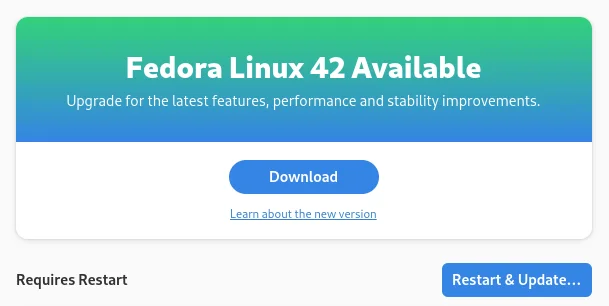Fedora Linux 42 Now Available
 Fedora Workstation 42: A Overview of New Features and Technical Highlights
Fedora Workstation 42: A Overview of New Features and Technical Highlights
Fedora Workstation 42 delivers an impressive array of innovations and improvements that benefit both regular users and developers. From a new web-based installer to advanced technical features, this release sets new standards in the Linux desktop space.
 The New Anaconda Web UI Installer: Making Installation Easy
The New Anaconda Web UI Installer: Making Installation Easy
Fedora 42 introduces the new web-based Anaconda installer as the standard solution. This fundamental redesign offers:
- A modernized, user-friendly interface with intuitive guidance
- Clear help text and progress indicators
- The option to skip certain installation steps
- Significantly simplified partitioning for beginners
- A quick installation option for experienced users
- Improved support for dual-boot configurations with other operating systems
 GNOME 48: Desktop Environment with Numerous Improvements
GNOME 48: Desktop Environment with Numerous Improvements
The Workstation edition ships with GNOME 48 and brings these highlights:
- Well-Being Feature: Analyzes screen time and reminds you to take regular breaks
- Dynamic Triple Buffering: Provides noticeably smoother animations and reduces stuttering
- Stacked Notifications: App notifications are intelligently grouped for better overview
- New System Fonts: Adwaita Sans and Adwaita Mono offer a fresh appearance
- Extended Image Editing: The image viewer receives basic editing functions
- HDR Support: Improved display of HDR content
- Time zone function in the calendar app
- Better Accessibility: The Orca screen reader is now fully usable under Wayland
 KDE Plasma as an Equal Edition for the First Time
KDE Plasma as an Equal Edition for the First Time
A milestone in Fedora history: KDE Plasma is no longer a spin variant but an official main edition on par with GNOME. Version 6.3.4 brings:
- Full support on all platforms, including PowerPC and ARM
- Emulation of x86 applications on non-x86 systems
- The full range of features of the popular KDE interface
 COSMIC: The New Rust-based Desktop as an Official Spin
COSMIC: The New Rust-based Desktop as an Official Spin
For the first time, the COSMIC desktop developed by System76 is available as an official spin. Although still in alpha stage, it already impresses with:
- Efficient window tiling for productive work
- Intelligent tab switching
- High adaptability to personal workflows
- Modern Rust codebase for stability and performance
 Windows Integration: Fedora Now Officially Available for WSL
Windows Integration: Fedora Now Officially Available for WSL
Windows users can rejoice: Fedora 42 offers official images for the Windows Subsystem for Linux (WSL) for the first time. This enables:
- Easy entry into the Fedora world without dual boot or virtualization
- Seamless integration of Linux development tools in Windows
- Official support from the Fedora project
 Speech Recognition: IBus Speech-to-Text
Speech Recognition: IBus Speech-to-Text
The new offline speech control ibus-speech-to-text enables:
- Voice input in all IBus-compatible applications
- Multilingual support without cloud connection
- Privacy-friendly local processing
 DNF5: Improved Package Management
DNF5: Improved Package Management
The DNF5 package manager brings improvements in system maintenance:
- Automatic removal of expired repository keys
- Increased security during software upgrades
- Simplified package management
 Developer Tools Up to Date
Developer Tools Up to Date
Fedora 42 delivers a wealth of updated developer tools:
- GCC 15 and binutils 2.44
- glibc 2.41 and gdb 15+
- Golang 1.24 and LLVM 20
- PHP 8.4
- Python 3.13.3
- Ruby 3.4
- PostgreSQL 17
Note: Python 3.8 and PostgreSQL 15 have been removed from the repository, PostgreSQL 16 is available.
 Technical Innovations Under the Hood
Technical Innovations Under the Hood
- Copy-on-Write (CoW): All Fedora editions now support CoW based on Btrfs reflinking
- Improved ARM Support: Optimizations for Apple Silicon and other ARM systems
- FEX Emulation Stack: Enables running x86 applications on ARM hardware
 Upgrade to Fedora 42 using the graphical method with GNOME Software
Upgrade to Fedora 42 using the graphical method with GNOME Software
For most desktop users, the easiest way to upgrade to Fedora 42 is to use the graphical software application:
- Open the GNOME Software application
- Go to the Updates tab
- A notification about the new Fedora release will appear. Click Download and begin the upgrade process.
 Upgrade to Fedora 42 via Terminal
Upgrade to Fedora 42 via Terminal
For those who prefer working with the command line, here are the steps to upgrade to Fedora 42:
# Bring system up to date
sudo dnf upgrade --refresh
# Install DNF plugin for system upgrades (if not already present)
sudo dnf install dnf-plugin-system-upgrade
# Download the upgrade to Fedora 42
sudo dnf system-upgrade download --releasever=42
# Reboot system and perform upgrade
sudo dnf system-upgrade rebootImportant notes:
- Be sure to create a backup of your important data before upgrading
- Plan enough time, as download and installation can take several hours depending on internet speed and system
- Ensure your system is powered throughout the entire process
After rebooting, you'll find yourself in a fresh Fedora 42 installation with all the new features described above.
 Farewell and Preview
Farewell and Preview
Fedora 42 marks the end of an era: It is the last release under the leadership of project leader Matthew Miller. His successor will be Jef Spaleta, who will shape the future of the project.
Blog: https://fedoramagazine.org/whats-new-fedora-workstation-42/
Download: https://fedoraproject.org/
Please also mark the comments that contributed to the solution of the article
Content-ID: 671393
Url: https://rootdb.com/info/fedora-linux-42-now-available-671393.html
Printed on: April 21, 2025 at 04:04 o'clock
Series: Fedora
Fedora Linux 42 Now AvailableResolving Standby Problems Caused by USB Devices on Fedora Linux 41Linux NetworkManager - Adding a search domain using nmcli or nmtui2